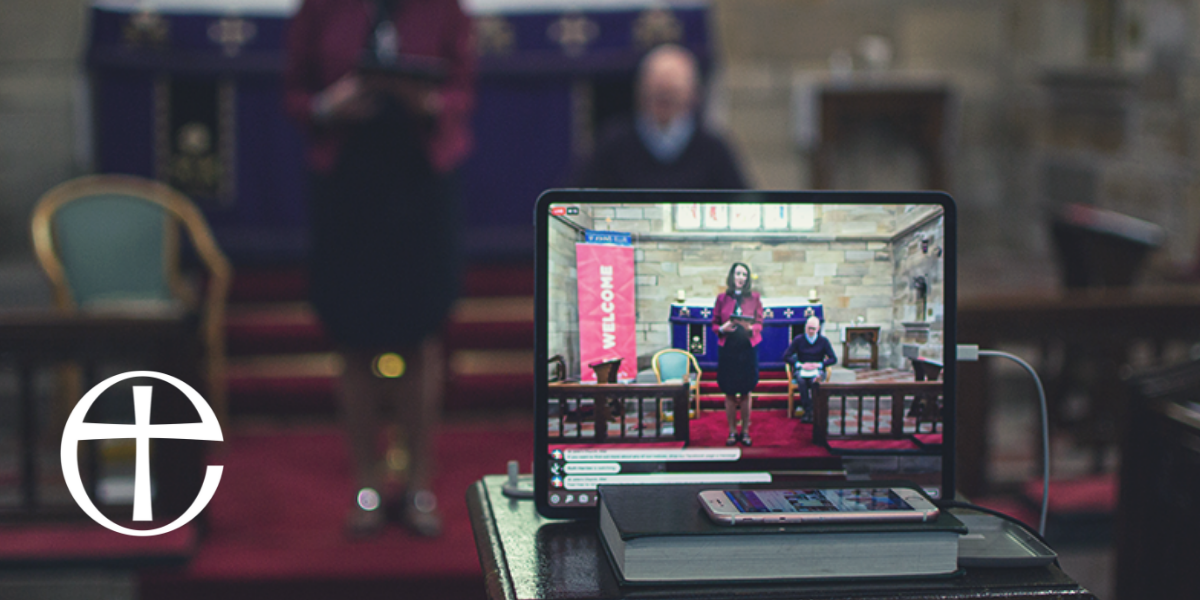There will be considerations based on time, budget and the community which are unique to your church and the wider community you serve.
Here we will cover a wide range of ideas, starting with a simple approach and taking steps up in complexity. We hope that you will be able to discover your own level, take ideas and inspiration and apply it to your own setting.
Advice for creative hybrid church services
A mixed-ecology or hybrid church service is not just a normal service in a church building that is livestreamed or recorded. In order for people joining in online to feel as much part of the congregation as people in the building, it really helps to think through how you might change or adapt the structure and content of your service to make it engaging and enable everyone to worship and learn through it.
Duration: It is hard for people to sit through a long church service if they are watching it on a screen. 30 to 45 minutes is a good length to keep people engaged all the way through.
Content: If you watch a TV news programme or magazine programme like Blue Peter or The One Show you will see that it is broken up into lots of different segments and short lines of script. Similarly, an online church service will be easier to watch if there are not too many long blocks of speech or the same shot on just one person for a long time. It may mean adapting the liturgy (spoken words and prayers) you use to be shorter, involving more people up-front, or varying your camera shots.
There is some useful guidance about planning here.
Variety
A hybrid service that features several people will be more interesting than a service led by just one person. Think about how you can involve different people in the various sections of the service. Online services are also a great opportunity to involve new people from your local community. People are often happy to be filmed for an online service even if they do not normally do ‘up-front’ stuff in church. Those watching also enjoy seeing someone they know pop up on the screen.
Familiarity
Having a core rota of 3 or 4 service leaders/presenters is helpful to build a sense of familiarity and consistency for those watching online. (A bit like knowing all the presenters on Countryfile or The Great British Bake Off!)
Presentation
- If you feel nervous about being on camera, take some deep breaths beforehand. Try to give yourself a couple of minutes’ quiet to focus on the service ahead just before it starts.
- Remember to smile, look into the camera and speak slowly and clearly. It helps your online audience to feel a connection with you and will ensure that no one is left struggling to understand you.
- If something goes wrong or your mind goes blank, try not to panic – just take a deep breath and allow yourself time to recover (people watching will just assume you are pausing for effect!)
- You might want to download an autocue/teleprompter app so you can read your words while still looking at the camera.
- If you are not wearing clerical robes, try to wear a single colour top and avoid patterned clothing which can look distracting on screen. For the same reason try to make sure your hair looks neat and your glasses are on straight etc. If you are wearing a lapel microphone, make sure the cable is tucked out of sight.
Read 11 essential tips for your next video presentation for more tips.
Positioning
Try to make sure you are standing in the best place for people watching online to see and hear you clearly. That means being close enough to the camera. It may mean doing your sermon from in front of the altar rather than at a fixed lectern, for example.
Read about useful advice on how best to frame a camera shot.
Inclusive
Make sure you spend time welcoming your online congregation and introduce yourself at the beginning of the service. Address the camera/s directly at various points in the service. If there is a part of the service they won’t be able to see, make sure you describe what is happening off-camera.
Read this blog for more great advice about how to make your church service as inclusive as possible.
Consent
It is courteous to let your online church congregation know that the service is going to be livestreamed and get their consent if you would like to show any shots of them or their children.
It is also important to film sensitively. People are coming to pray and worship and it can be intrusive if you film them receiving communion, or even having a doze during the sermon!
Keep the cameras facing towards the action at the front, unless you have a good reason for turning them onto the congregation and have asked permission beforehand. During a time of communion or prayer ministry, you could focus on a candle or the cross rather than people.
Read about filming and taking photographs in churches – Consent and GDPR for more advice.
Getting help
Creative service planning works best as a team effort. It is worth trying to grow a small team of volunteers to work with you. Some people love the tech side of things and this could be a good opportunity for them to use their skills, while others are full of creative ideas or good at planning and organising. It is good to have someone in overall charge of planning the service (a producer) so that decisions get made and people know who to defer to. Digital ministry could be an important new area for vocations and when it goes well it is also lots of fun.
If growing a team is not something that is possible right now, do consider what you are able to manage on your own. We have included a wide range of advice to suit many different churches, however, some ideas may require more volunteers than others. What is possible for you right now? This could be a simple livestream or recording of your sermon shared on social media, or a 30-minute Zoom chat and prayer on Thursday morning.
Learning from film, TV, radio and social media
Next time you are watching a television programme, listening to the radio or scrolling through Instagram, think about the sounds and images which really stick with you and the story they are telling. How have the programme-makers brought a subject to life and made it memorable for you? Think about how you could use some of these ideas in your online services!
Think and discuss
- Is online a full expression of worship or a staging post to joining in person?
- How can you mitigate the problem with online sacraments?







